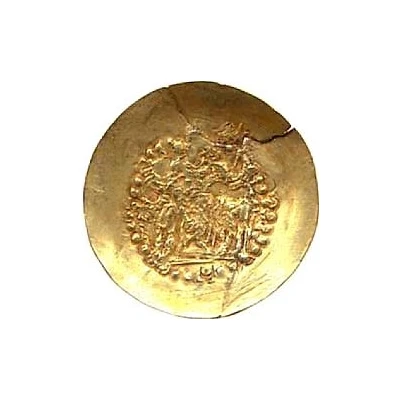


© Numismatics.hu
Dinar - Kidara I Gandhara
| Gold (.986) | 7.81 g | - |
| Issuer | Kidarite Kingdom |
|---|---|
| Type | Standard circulation coin |
| Years | 350-385 |
| Value | Dinar (20) |
| Currency | Drachm (380-477) |
| Composition | Gold (.986) |
| Weight | 7.81 g |
| Shape | Round (irregular) |
| Technique | Hammered |
| Demonetized | Yes |
| Updated | 2024-10-10 |
| Numista | N#85454 |
|---|---|
| Rarity index | 92% |
Reverse
Lettering: Ardoxso seated, facing
Comment
References: Joe Cribb: Early Medieval Kashmir Coinage (Numismatic Digest 40) #16, Cribb, Kidarites B3; MK 609; ANS Kushan 2414; Donum Burns 807-9Kidara I (fl. 350-385 CE) was the first ruler of the Kidarite Kingdom, which replaced the Indo-Sasanians in northwestern India, in the areas of Kushanshahr, Gandhara, Kashmir and Punjab. Kidara struck both Sasanian-style silver coins (imitating his immediate predecessor in the region Bahram Kushanshah) and Kushan-style gold coins.
Interesting fact
One interesting fact about the Dinar - Kidara I (Gandhara) coin is that it features a unique blend of Indian and Greek influences in its design. The coin's obverse side bears the image of King Kidara I, who is depicted with a long beard and a crown that resembles the Greek royal diadem. The reverse side of the coin features a representation of the Hindu goddess Lakshmi, who is seated on a lotus flower and surrounded by symbols of prosperity and good fortune. This fusion of cultural influences reflects the rich cultural heritage of the Kidarite Kingdom, which was a major center of trade and cultural exchange between India and the Mediterranean world during the 4th century CE.



